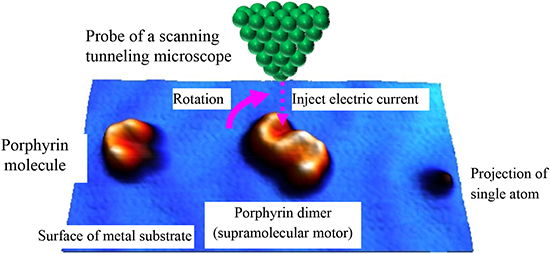Manipulating the Rotational Direction of Artificial Molecular Motors Using Supramolecules
Pioneering Mass Production of Versatile Nanomachines
2015.06.26
(2015.09.01 Update)
National Institute for Materials Science (NIMS)
Institute for Chemical Research, Kyoto University
A NIMS MANA group and a research team at the Institute for Chemical Research of Kyoto University jointly fabricated molecular motors on a metal substrate using supramolecules, and successfully reversed rotation of molecular motors by rearranging bonding between molecules that constitute a supramolecule.
Abstract
- A research group consisting of Takashi Uchihashi, MANA Scientist, Jonathan Hill, MANA Scientist, Tomonobu Nakayama, Unit Director, and Christian Joachim, MANA Principal Investigator (also a group leader at the CEMES-CNRS, France), at the NIMS International Center for Materials Nanoarchitectonics (MANA), along with a research team led by Professor Teruo Ono at the Institute for Chemical Research of Kyoto University, jointly fabricated molecular motors on a metal substrate using supramolecules, and successfully reversed rotation of molecular motors by rearranging bonding between molecules that constitute a supramolecule.
- A molecular motor is a kind of nanomachine vital in sustaining everyday activities of living organisms. It is a dream of nanotechnology researchers to fabricate a mechanical system driven by nanomachines in the same manner that biological systems develop molecular motors in a self-organizing fashion. While molecular motors already have been created on substrate surfaces using organic molecules, they had a major issue in that they were incapable of switching their rotational direction. This issue is caused by their structural rigidity associated with strong bonding among the molecules that comprise a motor.
- In this study, the joint research team fabricated structurally flexible molecular motors using a supramolecule, and succeeded for the first time in manipulating the rotational direction of the motors. A supramolecule has a complex structure, consisting of several molecules that are loosely connected to each other by hydrogen bonds and/or other kinds of weaker bonds relative to covalent bonds. A motor made of a supramolecule rotates in one direction when electric current is injected into the molecule. In addition, the team succeeded in reversing the motor’s rotational direction by rearranging motor parts via application of electric current under certain conditions. The team accomplished this because supramolecule-comprising molecules were bonded by moderate strength, which is neither too strong nor too weak. Moreover, since the team applied the principle of self-organization in biological systems to the fabrication of molecular motors, they believe that mass production of the products is feasible.
- Building on these positive outcomes, the team will aim to create nanomachines with superior functionality at a larger scale. Also, studies on the behavior of artificial molecular motors may help understand the detailed mechanism of how naturally-occurring molecular motors in biological systems work.
- This study was conducted as a part of a Grant-in-Aid for Challenging Exploratory Research program titled “Creation of a new molecular motor based on the Einstein-de Haas effect” (Takashi Uchihashi, principal investigator).
- This research was published in Nano Letters, an American Chemical Society journal, on June 22, 2015.

Conceptual diagram showing a molecular motor in action. A porphyrin dimer rotates in the direction indicated by the solid arrow through injection of electric current into the dimer from the probe of a scanning tunneling microscope.
